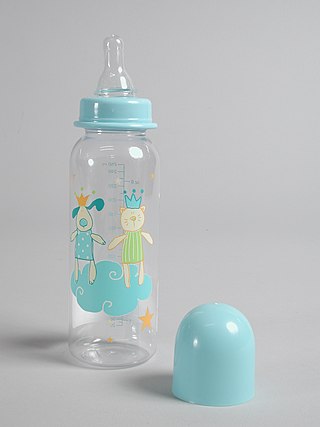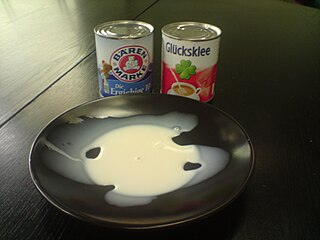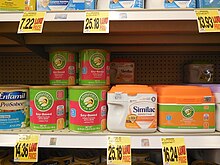
Infant formula, also called baby formula, simply formula, baby milk or infant milk, is an ultra-processed food designed and marketed for feeding to babies and infants under 12 months of age, usually prepared for bottle-feeding or cup-feeding from powder or liquid. The U.S. Federal Food, Drug, and Cosmetic Act (FFDCA) defines infant formula as "a food which purports to be or is represented for special dietary use solely as a food for infants by reason of its simulation of human milk or its suitability as a complete or partial substitute for human milk".

Nestlé S.A. is a Swiss multinational food and drink processing conglomerate corporation headquartered in Vevey, Vaud, Switzerland. It has been the largest publicly held food company in the world, measured by revenue and other metrics, since 2014. It ranked No. 64 on the Fortune Global 500 in 2017 and No. 33 in the 2016 edition of the Forbes Global 2000 list of the largest public companies.

A baby bottle, nursing bottle, or feeding bottle is a bottle with a teat attached to it, which creates the ability to drink via suckling. It is typically used by infants and young children, or if someone cannot drink from a cup, for feeding oneself or being fed. It can also be used to feed non-human mammals.

Evaporated milk, known in some countries as "unsweetened condensed milk", is a shelf-stable canned cow’s milk product where about 60% of the water has been removed from fresh milk. It differs from sweetened condensed milk, which contains added sugar. Sweetened condensed milk requires less processing to preserve since the added sugar inhibits bacterial growth. The production process involves the evaporation of 60% of the water from the milk, followed by homogenization, canning, and heat-sterilization.

Breast milk or mother's milk is milk produced by mammary glands located in the breast of a human female. Breast milk is the primary source of nutrition for newborns, containing fat, protein, carbohydrates and variable minerals and vitamins. Breast milk also contains substances that help protect an infant against infection and inflammation, whilst also contributing to healthy development of the immune system and gut microbiome.
A boycott was launched in the United States on July 4, 1977, against the Swiss-based multinational food and drink processing corporation Nestlé. The boycott expanded into Europe in the early 1980s and was prompted by concerns about Nestlé's "aggressive marketing" of infant formulas, particularly in underdeveloped countries. The boycott has been cancelled and renewed because of the business practices of Nestlé and other substitute manufacturers monitored by the International Baby Food Action Network (IBFAN). Organizers of the boycott as well as public health researchers and experts consider breast milk to be the best nutrition source for infants. The World Health Organization (WHO) recommends infants to be exclusively breastfed for the first six months of their lives, nevertheless, sometimes nutritional gaps need to be filled if breastfeeding is unsuitable, not possible, or inadequate.

Baby food is any soft easily consumed food other than breastmilk or infant formula that is made specifically for human babies between six months and two years old. The food comes in many varieties and flavors that are purchased ready-made from producers, or it may be table food eaten by the family that has been mashed or otherwise broken down.
The International Code of Marketing of Breast-milk Substitutes is an international health policy framework for breastfeeding promotion adopted by the World Health Assembly (WHA) of the World Health Organization (WHO) in 1981. The Code was developed as a global public health strategy and recommends restrictions on the marketing of breast milk substitutes, such as infant formula, to ensure that mothers are not discouraged from breastfeeding and that substitutes are used safely if needed. The Code also covers ethical considerations and regulations for the marketing of feeding bottles and teats. A number of subsequent WHA resolutions have further clarified or extended certain provisions of the Code.
Derrick B. Jelliffe and his wife Eleanore. F. Patrice Jelliffe – known as Dick and Pat Jelliffe – were experts in tropical paediatrics and infant nutrition. They are most known for their seminal book, Human Milk in the Modern World, published by Oxford University Press in 1978, and for editing the multi-volume Advances in International Maternal and Child Health. The Jelliffes also wrote over 500 scholarly papers, often together, and 22 books. They lived and worked in England, Africa, India, the Caribbean and settled in Los Angeles, where he held the Chair in Public Health and Paediatrics at the University of California from 1972 to 1990.

Breastfeeding, or nursing, is the process by which human breast milk is fed to a child. Breast milk may be from the breast, or may be pumped and fed to the infant. The World Health Organization (WHO) recommends that breastfeeding begin within the first hour of a baby's life and continue as often and as much as the baby wants. Health organizations, including the WHO, recommend breastfeeding exclusively for six months. This means that no other foods or drinks, other than vitamin D, are typically given. The WHO recommends exclusive breastfeeding for the first 6 months of life, followed by continued breastfeeding with appropriate complementary foods for up to 2 years and beyond. Of the 135 million babies born every year, only 42% are breastfed within the first hour of life, only 38% of mothers practice exclusive breastfeeding during the first six months, and 58% of mothers continue breastfeeding up to the age of two years and beyond.

A human milk bank, breast milk bank or lactarium is a service that collects, screens, processes, pasteurizes, and dispenses by prescription human milk donated by nursing mothers who are not biologically related to the recipient infant. The optimum nutrition for newborn infants is breast milk for at least the first 6 months of life. For women who are unable to breast feed or produce enough milk, pasteurized donor breast milk may be an effective approach to feeding. Breast milk supplied by a woman other than the baby's mother that is not pasteurized and informal breast milk sharing is associated with a risk of transmitting bacteria and viruses from the donor mother to the baby and is not considered a safe alternative. If pasteurized donor breast milk is not available, commercial formula is suggested as a second alternative.

In Western countries extended breastfeeding usually means breastfeeding after the age of 12 to 24 months, depending on the culture.
Infant feeding is the practice of feeding infants. Breast milk provides the best nutrition when compared to infant formula. Infants are usually introduced to solid foods at around four to six months of age.
BabyNes is a beverage machine by Nestlé that makes infant formula from single-use capsules, similar to Nestlé's Nespresso. The product was designed to recreate Nespresso's success with coffee in the baby formula industry. It was first introduced in Switzerland on May 25, 2011. The Wall Street Journal referred to Nespresso as Nestlé's fastest growing brand in 2011 after its sales rose by 20% in 2010 and it brought a number of legal actions against competitors. Nestlé reported strong sales for the product in late 2011.
Late preterm infants are infants born at a gestational age between 34+0⁄7 weeks and 36+6⁄7 weeks. They have higher morbidity and mortality rates than term infants due to their relative physiologic and metabolic immaturity, even though they are often the size and weight of some term infants. "Late preterm" has replaced "near term" to describe this group of infants, since near term incorrectly implies that these infants are "almost term" and only require routine neonatal care.

Foodborne illness is any illness resulting from the food spoilage of contaminated food, pathogenic bacteria, viruses, or parasites that contaminate food. Infant food safety is the identification of risky food handling practices and the prevention of illness in infants. Foodborne illness is a serious health issue, especially for babies and children. Infants and young children are particularly vulnerable to foodborne illness because their immune systems are not developed enough to fight off foodborne bacterial infections. In fact, 800,000 illnesses affect children under the age of 10 in the U.S. each year. Therefore, extra care should be taken when handling and preparing their food.

Shazi Visram is an American entrepreneur, investor, and philanthropist, best known as the founder, CEO, and Chief Mom of Happy Family Brands. In 2013, she was acknowledged by President Barack Obama as "not only an outstanding businesswoman, but also a leader that all of us can emulate."
Nestlé-Wyeth Nutrition provides food products to meet the needs of infants, young children and adults. Through scientific research, they claim to help nourish children when breastfeeding is not an option. Wyeth Nutrition started in 1915 when Henry Grestberger manufactured the first formula patterned after breast milk called SMA. Wyeth Pharmaceuticals, formerly Wyeth-Ayerst Laboratories, is the original company founded by the Wyeth brothers, originally known as John Wyeth and Brother. They focused on the research, development, and marketing of prescription drugs. The pharmaceuticals division was further subdivided into five subdivisions: Wyeth Research, Prescription Products, Biotech, Vaccines, and Nutritionals. Wyeth's research and development director Robert Ruffolo was quoted in The New York Times about the firm's efforts to develop new drugs.

In 2022, the United States experienced a severe shortage of infant formula as a result of the 2021–2022 global supply chain crisis compounded by a large scale product recall after two babies allegedly died after consuming Abbott infant formula, import restrictions, and market concentration. Unlike other food products, infant formula often does not have an available and acceptable substitute as a source of nutrition for those who rely on it. In addition to infants, the formula recalls affected non-infant medical patients who require nasogastric feeding or have certain other conditions.

Bobbie is an American infant formula company based in San Francisco, California. It was founded by Laura Modi and Sarah Hardy.












